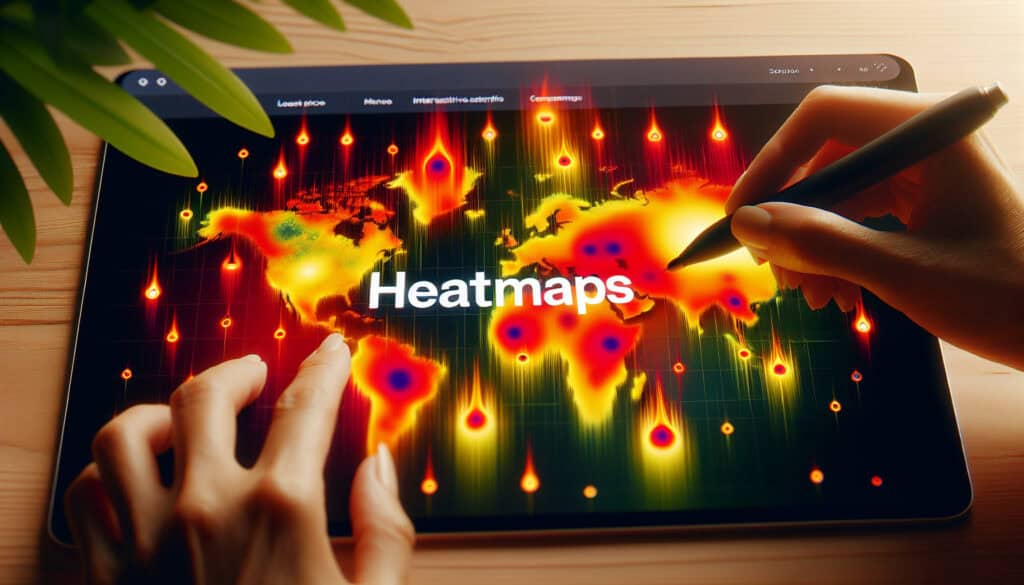To visualize where users click, move, and scroll on a website.
- Méthodologies : Clients et marketing, Idéation, Conception de Produits
Heatmaps

Heatmaps
- Taux de conversion, Expérience client, Conception pour la durabilité, Pensée conceptuelle, Conception d'interaction, Utilisabilité, Tests d'utilisabilité, Expérience utilisateur (UX), Interface utilisateur (UI)
Objectif :
Comment il est utilisé :
- A graphical representation of data where values are depicted by color. Website heatmaps show where users have clicked on a page, how far they have scrolled, and where they have moved their mouse. This helps to understand user behavior and identify areas for improvement.
Avantages
- Provides a clear and visual way to understand user behavior; Helps to identify usability issues and optimize conversions.
Inconvénients
- Does not explain the 'why' behind user behavior; Can be misleading if not interpreted correctly.
Catégories :
- Clients et marketing, Conception de Produits
Idéal pour :
- Optimizing the layout and design of a website to improve user engagement and conversions.
Heatmaps, as a graphical representation of data denoting different values through color variations, find extensive utility in various industries such as e-commerce, digital marketing, software development, and user experience design. Common applications include analyzing user interactions on landing pages, mobile apps, and dashboards, providing designers and developers with the ability to visualize where users are most engaged and where they drop off. The methodology is particularly adaptable during the testing phase of a cycle de vie du produit, especially in conjunction with A/B testing and user feedback sessions, allowing teams to refine layouts, content placement, and call-to-action elements effectively. Participants in this process typically include UX/UI designers, data analysts, product managers, and marketing specialists, all of whom collaborate to interpret heatmap data and implement actionable changes to enhance user experience. Tools such as Crazy Egg or Hotjar facilitate this gathering of information, making it easier for teams to visualize interaction patterns, thus validating design choices with empirical evidence. This method not only accelerates the decision-making process but also directly ties user engagement metrics to design optimizations, ultimately aligning product functionalities with user expectations and preferences.
Principales étapes de cette méthodologie
- Define key metrics and goals for user behavior analysis.
- Select the type of heatmap to use (click, scroll, move).
- Integrate heatmap tracking code into the website.
- Monitor user interaction data over a specified period.
- Analyze the heatmap data for patterns in user engagement.
- Identify areas of the website that require optimization.
- Prioritize changes based on potential impact on conversions.
- Implement design changes based on heatmap insights.
- Conduct follow-up testing to evaluate the effectiveness of changes.
Conseils de pro
- Layer heatmaps with user session recordings to connect quantitative data with qualitative behaviors for deeper understanding of user interactions.
- Segment heatmap data based on user demographics or traffic sources to discern variations in behavior patterns and tailor strategies effectively.
- Integrate A/B testing results with heatmap findings, allowing for more informed decisions on design changes and their direct impact on engagement metrics.
Lire et comparer plusieurs méthodologies, nous recommandons le
> Référentiel méthodologique étendu <
ainsi que plus de 400 autres méthodologies.
Vos commentaires sur cette méthodologie ou des informations supplémentaires sont les bienvenus sur le site web de la Commission européenne. section des commentaires ci-dessous ↓ , ainsi que toute idée ou lien en rapport avec l'ingénierie.
Contexte historique
1986
(si la date est inconnue ou n'est pas pertinente, par exemple "mécanique des fluides", une estimation arrondie de son émergence notable est fournie)

Articles Similaires
Questionnaires sur les troubles musculo-squelettiques
Tests à plusieurs variables (MVT)
Analyse de régression multiple
Systèmes de capture de mouvement
Méthode MoSCoW
Test de la médiane de Mood